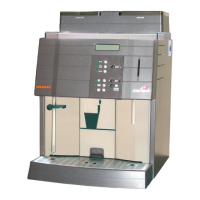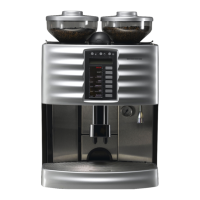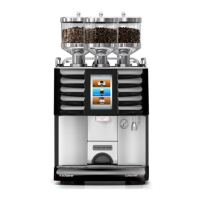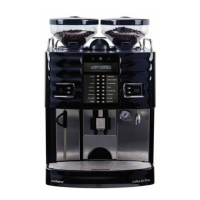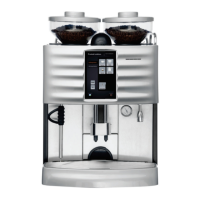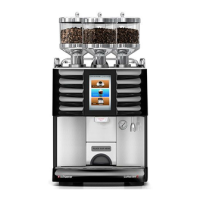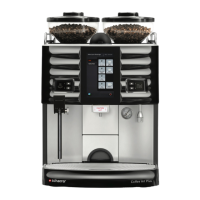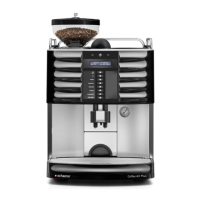Chapter 6 Control system diagram
SMSO-2-02.06- 15.07.03 179
6 Control system diagram
6.1 Safety regulations
DANGER TO LIFE
When carrying out any work on electrical
appliances, fatal injuries may be caused by
electric shock, if live parts are touched.
Even at low voltages, contact with live parts
can also cause bodily harm to people. Such
work must be carried out only by authorised
and qualified electricians.
If possible, always check the electrical circuits when they are
disconnected from the power supply . The following rules must
be observed here:
1. Isolate the machine (fully disconnect)
2. Make sure that it cannot be switched on again (lock and
label the switch)
3. Ascertain that it is fully disconnected (if necessary check
for external voltage from linked systems).
If you do in fact need to check the machine while it is con-
nected to the power supply, it is essential that you observe the
following rules:
Only use tools with insulated and voltage-tested handles.
Use the covers , casing or other suitable protection to
ensure that it is not possible accidentally to touch live
parts.
Ensure the unit is placed in an insulated location, and in
all cases use the voltage-tested gloves.
Do not carry out such tests alone, but always ensure that
another person with first aid skills in treating electric
shock is present, who in the case of an emergency can
take quick action.
6.2 Control system diagram
The control system diagram (several different versions of the
control system diagram) can be found in the info file. Please
note that the various series of Ambiente-2 have different con-
structions. For full information about cabling , plug and termi-
nal configurations and also the connection diagrams for com-
ponents, please see the control system diagram concerned.
The connection type for the most frequently occurring three-
phase current mains can also be found in the control system
diagram.
6.3 Technical diagram
The technical diagram gives an overview of the structure of
the entire control system for the coffee machine, including the
principle hydraulic systems. It also serves the following pur-
poses:
to illustrate the flow of power and signals to control the
individual product systems (coffee, tea steam etc.)
To act as the basis of illustrating the following diagrams
showing fault diagnosis and troubleshooting.
The technical diagram is a single-pole illustration, and shows
only the significant circuit components. Terminals, plugs etc.
are left out to keep the illustration as simple as possible. How-
ever, these elements are shown in the fault diagnosis and
troubleshooting diagrams.
6.4 Trouble-shooting electrical circuits
Almost all of the electrical circuits on an Ambiente-2 with re-
frigerator are illustrated separately on the pages that follow,
but without further optional features. It is an illustrated diagram
that can be used by all service technicians, who have little
experience of reading electrical circuit diagrams, systemati-
cally to test an electrical circuit. A checklist is provided with
each circuit diagram, containing numbered work steps. If you
carry out the tests in accordance with these steps, you will be
able to locate and correct even difficult-to-find faults.
Some tips for carrying out the inspections:
1. Work systematically (in accordance with the work steps)
2. For voltage tests always use a measuring instrument that
allows you to make bi-polar measurements. (Screwdriver
phase testers are unreliable, can be dangerous and are
therefore not recommended).
3. Always make sure you know the voltage range you are
testing, and adjust your measuring equipment accord-
ingly. It s also very important to know whether you are
testing a conventional or a transistor circuit (see “Func-
tional descriptions, transistors as switching circuit
4. When making inspections and measurements, you must
always consider the possibility that there might be two
main sources of fault: poor (oxidised) contacts, or broken
cables.
5. In cases of doubt, repeat a measurement, and only if the
results are the same can you assume that the measure-
ment is correct.
6. Us the initial test (see programming manual) for your
tests.
6.4.1 Voltage data
Mains voltages
Depending on local conditions, the effective mains voltage
measurements can vary considerably from the nominal volt-
age. This tolerance may be up to 10 % of the stated mains
voltage
Control voltages
The unstabilised control voltages may also vary widely from
the nominal value, in accordance with the voltage fluctuations
and tolerances.
Stabilised control voltages of 30V DC and 5V DC have no
tolerances, despite voltage fluctuations from the mains.
The machine has two 36V circuits , each one having a differ-
ent control function purpose.
1. 36V: The first electrical circuit is operational all the while
the machine is connected to the mains voltage. It is used
to supply all the safety relevant limit switches (panel
switches, drawer for coffee grounds, door to refrigerator,
and to supply the unit control system.
2. 36V S: The second 36V electrical circuit is switched via
relay 1 (main relay) This circuit controls all the consumers
or their load relays (ventilators, valves, heating unit load
relay, etc.) Relay 1 interrupts the 36V control circuit as
soon as one of the safety-relevant limit switches opens, or
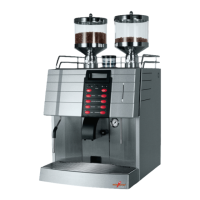
